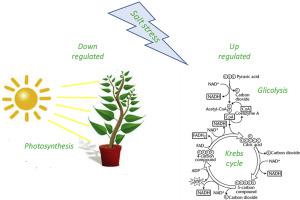当前位置:
X-MOL 学术
›
Phytochemistry
›
论文详情
Our official English website, www.x-mol.net, welcomes your feedback! (Note: you will need to create a separate account there.)
Transcriptional response of giant reed (Arundo donax L.) low ecotype to long-term salt stress by unigene-based RNAseq
Phytochemistry ( IF 3.8 ) Pub Date : 2020-09-01 , DOI: 10.1016/j.phytochem.2020.112436 Angelo Sicilia 1 , Danilo Fabrizio Santoro 1 , Giorgio Testa 1 , Salvatore Luciano Cosentino 1 , Angela Roberta Lo Piero 1
Phytochemistry ( IF 3.8 ) Pub Date : 2020-09-01 , DOI: 10.1016/j.phytochem.2020.112436 Angelo Sicilia 1 , Danilo Fabrizio Santoro 1 , Giorgio Testa 1 , Salvatore Luciano Cosentino 1 , Angela Roberta Lo Piero 1
Affiliation

|
The giant reed is a fast growing herbaceous non-food crop considered as eligible alternative energy source to reduce the usage of fossil fuels. Tolerance of this plant to abiotic stress has been demonstrated across a range of stressful conditions, thus allowing cultivation in marginal or poorly cultivated land in order not to compromise food security and to overcome land use controversies. In this work, we de novo sequenced, assembled and analyzed the A. donax low G34 ecotype leaf transcriptome (RNAseq analysis) subjected to severe long-term salt stress (256.67 mM NaCl corresponding to 32 dS m-1 electric conductibility). In order to shed light upon the response to high salinity of this non model plant, we analyzed clusters related to salt sensory and signaling transduction, transcription factors, hormone regulation, Reactive Oxygen Species (ROS) scavenging and osmolyte biosynthesis, all of them showing different regulation compared to untreated plants. The analysis of clusters related to ethylene biosynthesis and signaling indicated that gene transcription is modulated towards the minimization of ethylene negative effects upon plant growth. Certainly, the photosynthesis is strongly affected since genes involved in Rubisco biosynthesis and assembly are down-regulated. However, a shift towards C4 photosynthesis is likely to occur as gene regulation is aimed to activate the primary CO2 fixation to PEP (phosphoenolpyruvate). The analysis of "carbon metabolism" category revealed that G34 ecotype under salt stress induces the expression of glycolysis and Krebs cycle related genes, this being consistent with the hypothesis that some sort of salt avoidance might be occurred in A. donax G34 low ecotype. By comparing our results with findings obtained with other giant reed ecotype, we identified several differences in the response to salt that are in accordance with the possibility that heritable phenotypic differences among clones of A. donax might be accumulated especially in ecotypes originating from distant geographical areas, despite their asexual reproduction modality. Additionally, 26,838 simple sequence repeat (SSR) markers were identified and validated. This SSR dataset definitely expands the marker catalogue of A. donax facilitating the genotypic characterization of this species.
中文翻译:

基于 unigene 的 RNAseq 对巨型芦苇 (Arundo donax L.) 低生态型对长期盐胁迫的转录反应
巨型芦苇是一种快速生长的草本非粮食作物,被认为是减少化石燃料使用的合格替代能源。这种植物对非生物胁迫的耐受性已在一系列压力条件下得到证明,因此允许在边缘或贫瘠的土地上种植,以免危及粮食安全并克服土地使用争议。在这项工作中,我们从头测序、组装和分析了遭受严重长期盐胁迫(256.67 mM NaCl 对应于 32 dS m-1 电导率)的芦荟低 G34 生态型叶转录组(RNAseq 分析)。为了阐明这种非模式植物对高盐度的反应,我们分析了与盐感觉和信号转导、转录因子、激素调节、活性氧 (ROS) 清除和渗透剂生物合成,与未经处理的植物相比,所有这些都显示出不同的调节。对与乙烯生物合成和信号传导相关的簇的分析表明,基因转录被调节以尽量减少乙烯对植物生长的负面影响。当然,光合作用受到强烈影响,因为参与 Rubisco 生物合成和组装的基因被下调。然而,由于基因调控旨在激活对 PEP(磷酸烯醇丙酮酸)的初级 CO2 固定,因此可能会发生向 C4 光合作用的转变。“碳代谢”类别分析表明,盐胁迫下G34生态型诱导糖酵解和三羧酸循环相关基因的表达,这与在 A. donax G34 低生态型中可能发生某种盐分避免的假设一致。通过将我们的结果与其他巨型芦苇生态型的发现进行比较,我们确定了对盐的反应的一些差异,这与芦苇克隆之间的遗传表型差异可能会累积的可能性一致,尤其是在源自遥远地理区域的生态型中,尽管它们是无性繁殖方式。此外,还鉴定并验证了 26,838 个简单序列重复 (SSR) 标记。这个 SSR 数据集肯定扩展了 A. donax 的标记目录,促进了该物种的基因型表征。我们确定了对盐的反应的一些差异,这与 A. donax 克隆之间的遗传表型差异可能会累积的可能性一致,特别是在源自遥远地理区域的生态型中,尽管它们的无性繁殖方式。此外,还鉴定并验证了 26,838 个简单序列重复 (SSR) 标记。这个 SSR 数据集肯定扩展了 A. donax 的标记目录,促进了该物种的基因型表征。我们确定了对盐的反应的一些差异,这与 A. donax 克隆之间的遗传表型差异可能会累积的可能性一致,特别是在源自遥远地理区域的生态型中,尽管它们的无性繁殖方式。此外,还鉴定并验证了 26,838 个简单序列重复 (SSR) 标记。这个 SSR 数据集肯定扩展了 A. donax 的标记目录,促进了该物种的基因型表征。鉴定并验证了 838 个简单序列重复 (SSR) 标记。这个 SSR 数据集肯定扩展了 A. donax 的标记目录,促进了该物种的基因型表征。鉴定并验证了 838 个简单序列重复 (SSR) 标记。这个 SSR 数据集肯定扩展了 A. donax 的标记目录,促进了该物种的基因型表征。
更新日期:2020-09-01
中文翻译:

基于 unigene 的 RNAseq 对巨型芦苇 (Arundo donax L.) 低生态型对长期盐胁迫的转录反应
巨型芦苇是一种快速生长的草本非粮食作物,被认为是减少化石燃料使用的合格替代能源。这种植物对非生物胁迫的耐受性已在一系列压力条件下得到证明,因此允许在边缘或贫瘠的土地上种植,以免危及粮食安全并克服土地使用争议。在这项工作中,我们从头测序、组装和分析了遭受严重长期盐胁迫(256.67 mM NaCl 对应于 32 dS m-1 电导率)的芦荟低 G34 生态型叶转录组(RNAseq 分析)。为了阐明这种非模式植物对高盐度的反应,我们分析了与盐感觉和信号转导、转录因子、激素调节、活性氧 (ROS) 清除和渗透剂生物合成,与未经处理的植物相比,所有这些都显示出不同的调节。对与乙烯生物合成和信号传导相关的簇的分析表明,基因转录被调节以尽量减少乙烯对植物生长的负面影响。当然,光合作用受到强烈影响,因为参与 Rubisco 生物合成和组装的基因被下调。然而,由于基因调控旨在激活对 PEP(磷酸烯醇丙酮酸)的初级 CO2 固定,因此可能会发生向 C4 光合作用的转变。“碳代谢”类别分析表明,盐胁迫下G34生态型诱导糖酵解和三羧酸循环相关基因的表达,这与在 A. donax G34 低生态型中可能发生某种盐分避免的假设一致。通过将我们的结果与其他巨型芦苇生态型的发现进行比较,我们确定了对盐的反应的一些差异,这与芦苇克隆之间的遗传表型差异可能会累积的可能性一致,尤其是在源自遥远地理区域的生态型中,尽管它们是无性繁殖方式。此外,还鉴定并验证了 26,838 个简单序列重复 (SSR) 标记。这个 SSR 数据集肯定扩展了 A. donax 的标记目录,促进了该物种的基因型表征。我们确定了对盐的反应的一些差异,这与 A. donax 克隆之间的遗传表型差异可能会累积的可能性一致,特别是在源自遥远地理区域的生态型中,尽管它们的无性繁殖方式。此外,还鉴定并验证了 26,838 个简单序列重复 (SSR) 标记。这个 SSR 数据集肯定扩展了 A. donax 的标记目录,促进了该物种的基因型表征。我们确定了对盐的反应的一些差异,这与 A. donax 克隆之间的遗传表型差异可能会累积的可能性一致,特别是在源自遥远地理区域的生态型中,尽管它们的无性繁殖方式。此外,还鉴定并验证了 26,838 个简单序列重复 (SSR) 标记。这个 SSR 数据集肯定扩展了 A. donax 的标记目录,促进了该物种的基因型表征。鉴定并验证了 838 个简单序列重复 (SSR) 标记。这个 SSR 数据集肯定扩展了 A. donax 的标记目录,促进了该物种的基因型表征。鉴定并验证了 838 个简单序列重复 (SSR) 标记。这个 SSR 数据集肯定扩展了 A. donax 的标记目录,促进了该物种的基因型表征。


























 京公网安备 11010802027423号
京公网安备 11010802027423号